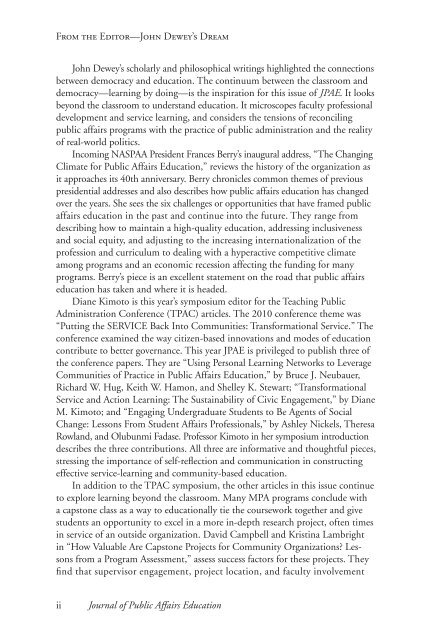Journal of Public Affairs Education
You also want an ePaper? Increase the reach of your titles
YUMPU automatically turns print PDFs into web optimized ePapers that Google loves.
From the Editor—John Dewey’s Dream<br />
John Dewey’s scholarly and philosophical writings highlighted the connections<br />
between democracy and education. The continuum between the classroom and<br />
democracy—learning by doing—is the inspiration for this issue <strong>of</strong> JPAE. It looks<br />
beyond the classroom to understand education. It microscopes faculty pr<strong>of</strong>essional<br />
development and service learning, and considers the tensions <strong>of</strong> reconciling<br />
public affairs programs with the practice <strong>of</strong> public administration and the reality<br />
<strong>of</strong> real-world politics.<br />
Incoming NASPAA President Frances Berry’s inaugural address, “The Changing<br />
Climate for <strong>Public</strong> <strong>Affairs</strong> <strong>Education</strong>,” reviews the history <strong>of</strong> the organization as<br />
it approaches its 40th anniversary. Berry chronicles common themes <strong>of</strong> previous<br />
presidential addresses and also describes how public affairs education has changed<br />
over the years. She sees the six challenges or opportunities that have framed public<br />
affairs education in the past and continue into the future. They range from<br />
describing how to maintain a high-quality education, addressing inclusiveness<br />
and social equity, and adjusting to the increasing internationalization <strong>of</strong> the<br />
pr<strong>of</strong>ession and curriculum to dealing with a hyperactive competitive climate<br />
among programs and an economic recession affecting the funding for many<br />
programs. Berry’s piece is an excellent statement on the road that public affairs<br />
education has taken and where it is headed.<br />
Diane Kimoto is this year’s symposium editor for the Teaching <strong>Public</strong><br />
Administration Conference (TPAC) articles. The 2010 conference theme was<br />
“Putting the SERVICE Back Into Communities: Transformational Service.” The<br />
conference examined the way citizen-based innovations and modes <strong>of</strong> education<br />
contribute to better governance. This year JPAE is privileged to publish three <strong>of</strong><br />
the conference papers. They are “Using Personal Learning Networks to Leverage<br />
Communities <strong>of</strong> Practice in <strong>Public</strong> <strong>Affairs</strong> <strong>Education</strong>,” by Bruce J. Neubauer,<br />
Richard W. Hug, Keith W. Hamon, and Shelley K. Stewart; “Transformational<br />
Service and Action Learning: The Sustainability <strong>of</strong> Civic Engagement,” by Diane<br />
M. Kimoto; and “Engaging Undergraduate Students to Be Agents <strong>of</strong> Social<br />
Change: Lessons From Student <strong>Affairs</strong> Pr<strong>of</strong>essionals,” by Ashley Nickels, Theresa<br />
Rowland, and Olubunmi Fadase. Pr<strong>of</strong>essor Kimoto in her symposium introduction<br />
describes the three contributions. All three are informative and thoughtful pieces,<br />
stressing the importance <strong>of</strong> self-reflection and communication in constructing<br />
effective service-learning and community-based education.<br />
In addition to the TPAC symposium, the other articles in this issue continue<br />
to explore learning beyond the classroom. Many MPA programs conclude with<br />
a capstone class as a way to educationally tie the coursework together and give<br />
students an opportunity to excel in a more in-depth research project, <strong>of</strong>ten times<br />
in service <strong>of</strong> an outside organization. David Campbell and Kristina Lambright<br />
in “How Valuable Are Capstone Projects for Community Organizations? Lessons<br />
from a Program Assessment,” assess success factors for these projects. They<br />
find that supervisor engagement, project location, and faculty involvement<br />
ii<br />
<strong>Journal</strong> <strong>of</strong> <strong>Public</strong> <strong>Affairs</strong> <strong>Education</strong>



